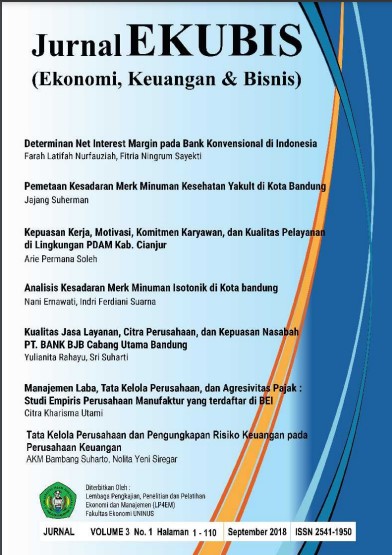DETERMINAN NET INTEREST MARGIN BANK KONVENSIONAL DI INDONESIA
Abstract
This study investigated the internal and external factors that affecting factor of Indonesia conventional commercial bank’s net interest margin on quarterly data of 21 banks during 2016Q1 to 2018Q3. The results reveal several main drivers of net interest margin in Indonesia. We found that BI 7-Days reverse repo rate and the ratio of operating expenses to operating income affect net interest margin negatively, meanwhile equity to total assets ratio and banks size affect net interest margin positively. It is recommended that empirical studies should be undertaken in the same field to find out what more internal factors could affect bank’ net interest margin in Indonesia.References
Almazari, A. A. (2014). Impact of Internal
Factors on Bank Profitability:
Comparative Study between Saudi
Arabia and Jordan. Journal of Applied
Finance & Banking, 4(1), 1-7.
Baltagi, B. H. (2008). Econometrics (4th ed.).
Springer.
Beck, T., & Hesse, H. (2009). Why are interest
spreads so high in Uganda. Journal of
Development Economics, 88, 192–204.
Brooks, C. (2008). Introductory Econometrics
for Finance (2nd ed.). Cambridge
University Press.
Chan, C. W., & Lopez, V. (2014, JulyAugustus). A Qualitative Descriptive
Study of Risk Reduction for Coronary
Disease among the Hong Kong Chinese.
Public Health Nursing (PHN), 31(4),
-335.
Creswell, J. W. (2012). Educational research:
Planning, conducting and evaluating
quantitative and qualititative research
(4th ed.). Boston: Pearson.
Creswell, J. W. (2014). Research Design:
Qualitative, Quantitative, & Mixed
Methods Approaches (4th ed.). London:
Sage Publications, Ltd.
Demerguc-Kunt, A., & Huizinga, H. (2000).
Determinants of Commercial Bank
Interest Margin and Profitablity: SomeInternational Evidence. Economic
Review. World Bank.
Hauner, D., & Peiris, S. (2005, December). Bank
Efficiency and Competition in LowIncome Countries: The Case of Uganda.
IMF Working Paper, 05, 240, 1-31. IMF.
Ho, T. S., & Saunders, A. (1981). The
Determinants of Bank Interest Margins:
Theory and Empirical Evidence. Journal
of Financial and Quantitative Analysis,
(4), 581-600.
Hou, X., Wang, Q., & Li, C. (2015). Role of offbalance sheet operations on bank scale
economies: Evidence from China's
banking sector. Emerging Markets
Review, 22, 140-153.
Kaufman, G. G. (2013, June). TOO BIG TO
FAIL IN BANKING: WHAT DOES IT
MEAN? Paper Series, SPECIAL PAPER
LSE FINANCIAL MARKETS
GROUP SPECIAL PAPER SERIES.
Kevin, A. (2018, Maret 29). cnbcindonesia.com.
Retrieved Maret 6, 2019, from CNBC
INDONESIA:
https://www.cnbcindonesia.com/market/
-17-9072/bankdomestik-terlalu-serakah-keruk-nim
Koran Jakarta. (2018, May 23).
http://www.koran-jakarta.com. Retrieved
February 25, 2019, from
http://www.koran-jakarta.com/marjinbunga-bank-terlalu-tinggi/
Lincoln, Y. S., & Guba, E. G. (2013). The
Constructivist Credo. Walnut Creek:
Left Coast Press, Inc.
López-Espinosa, G. M. (2011). Banks’ net
interest margin in the 2000s: A macroaccounting international perspective.
Journal of International Money and
Finance, 30, 1214–1233.
Mankiw, N. G. (2018). Principle of
Microeconomics (Eight ed.). Boston:
Cengage Learning.
Maudos, J., & Solís, L. (2009). The determinants
of net interest income in the Mexican
banking system: an integrated model.
Journal of Banking & Finance, 33,
-1931.
Maudosa, J., & Guevara, J. F. (2004). Factors
explaining the interest margin in the
banking sectors of the European Union.
Journal of Banking & Finance, 28,
–2281.
McShane, R., & Sharpe, I. (1985). A time
series/cross section analysis of the
determinant of Australian trading bank
loan/deposit interest margins: 1962-
Journal of Banking & Finance,
(1), 115-146.
Neuman, W. L. (2007). Basic of Social
Research: Qualitative & Quantitative
Approaches (2nd ed.). Pearson
Education, Inc.
Neuman, W. L. (2014). Social Research
Methods: Qualitative and Quantitative
Approaches (7th ed.). Harlow: Pearson
Education Limited.
Otoritas Jasa Keuangan. (2015). KEWAJIBAN
PEMENUHAN RASIO KECUKUPAN
LIKUIDITAS. Peraturan OJK NOMOR
/POJK.03/2015. Jakarta, Indonesia:
OJK.
Otoritas Jasa Keuangan. (2015). Staitistik
Perbankan Indonesia 2018. Jakarta:
OJK.
Otoritas Jasa Keuangan. (2017, Maret 17).
SURAT EDARAN OTORITAS JASA
KEUANGAN NOMOR
/SEOJK.03/2017. Surat Edaran.
Jakarta, Indonesia: OJK

